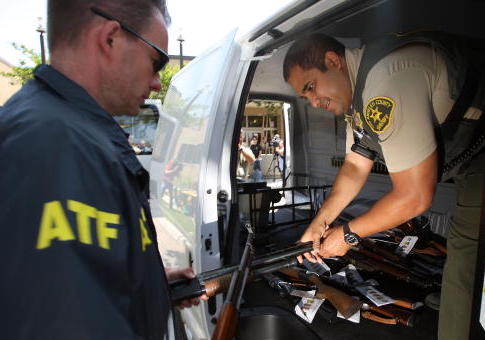Reports released by the Bureau of Alcohol, Tobacco, Firearms, and Explosives (ATF) on Wednesday show traces of crime guns that originated in the United States but ended up in Mexico or Central America were down by a wide margin in 2016.
One report shows traces of U.S.-sourced Mexican crime guns by the ATF's National Tracing Center dropped from 17,784 in 2015 to 13,452, a decline of more than 4,300 traces or nearly 25 percent. That's the fewest number of Mexican crime guns the ATF has traced in at least the last five years. The previous low point came in 2013 when the ATF traced 16,053 Mexican crime guns.
Similar reports from 2015 and 2016 show ATF traces of U.S.-sourced crime guns found in Central American countries down as well. Traces done in cooperation with the government of El Salvador fell from 4,068 in 2015 to 2,718 in 2016, a 33 percent decrease. Traces done in cooperation with the government of Panama fell from 688 in 2015 to 152 in 2016, a 77 percent decrease. Traces from Guatemala also saw a decrease of about 20 percent.
Belize, which sends relatively few trace requests to the United States, is the only Central American country in the ATF report which saw an increase in the number of traces conducted going from 31 traces in 2015 to 53 in 2016, a 70 percent increase.
Firearms tracing conducted by the ATF attempts to track identifying information, such as a serial number, of a firearm recovered at a crime scene back to the original legal purchaser of the firearm. That allows law enforcement officials to follow up with the purchaser and try to figure out how the firearm got from the original purchaser to the crime scene. This process is often difficult as many firearms recovered at crime scenes are decades old and have changed hands many times since it was first purchased.
The ATF said there were a variety of reasons for the drops in international trace requests. Amanda M. Hils, ATF public affairs specialist, told the Washington Free Beacon trace requests from El Salvador have fallen simply because that country had recovered fewer U.S.-sourced crime guns.
"In calendar year 2016, the trace numbers from El Salvador were lower than the previous year primarily because El Salvadorian law enforcement recovered fewer crime guns than the year prior," she said. "For any firearms they do recover, there is a comprehensive firearms tracing program in place that allows law enforcement to consistently trace those firearms."
Hils said trace requests from Mexico have dropped mainly because of changes to the country's judicial system, however, and not necessarily due to fewer U.S.-sourced crime guns being recovered there.
"In early 2013, the Mexican government streamlined their eTrace accounts, which decreased the number they previously had," Hils said. "Additionally, between 2015-2016, Mexico transitioned from an inquisitorial system to an accusatorial system of criminal prosecution. While adapting to this transition, there have been longer periods of time between the recoveries of firearms and trace requests than Mexico previously experienced. ATF continues to work with its Mexican law enforcement counterparts to develop best practices and train personnel during this time of transition to a new judicial process and operating with reduced amount of eTrace accounts."
Similarly, she said a change in the way Panama organizes its law enforcement was the likely cause of a drop in their trace requests.
"The decrease in firearm traces from Panama in calendar year 2016 arises primarily from Panamanian law enforcement transitioning from a centralized location for tracing firearms into many regional offices, which will further expedite and improve their ability to fight violent crime," Hils said. "During this period of transition, the existing program does face some logistical challenges and many new personnel requiring training, resulting in fewer trace requests than previous years."
The ATF said it expects trace requests to increase once the transition is completed.
"However, the effort to branch out into regional offices is being implemented so that Panamanian law enforcement will have additional tracing locations and personnel to better this process in the future," Hils said.
